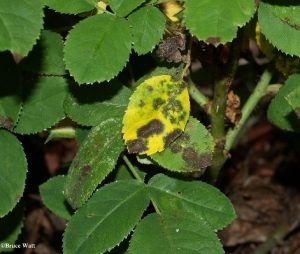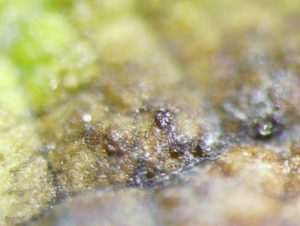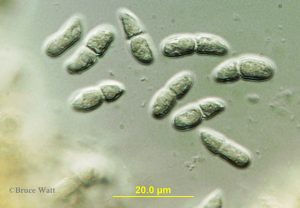Black Spot of Rose
Pest Management Fact Sheet #5097
Authors: Dr. Alicyn Smart, Dr. Bruce Watt, and Abigayl Novak
For information about UMaine Extension programs and resources, visit extension.umaine.edu.
Find more of our publications and books at extension.umaine.edu/publications/.
Other Name: Leaf blotch, Leaf spot, Blotch, Rose actinonema, Rose leaf asteroma, and Star sooty mold
Pathogen: Diplocarpon rosae (sexual stage) and Marssonina rosae (asexual stage)
Introduction
Black spot of rose is one of the most common and important diseases of roses throughout the world. In a natural environment, this disease is prevalent and becomes a major issue, frequently causing epidemics. It is caused by the fungus Diplocarpon rosae and will progressively weaken the plant so that fewer and fewer blooms form if the disease is left unchecked. Plants weakened by this disease are increasingly subject to winter injury.
As is true with most fungi, this fungus requires free water for infection to occur. The spores require at least 7 hours of wetness before they can germinate. Fruiting structures of the pathogen called acervuli form within two weeks of the initial infection. These structures release spores which are blown, splashed or otherwise carried to new tissue initiating new infections. A temperature of 65°F is ideal for spore germination and the disease develops most rapidly at about 75°F. Temperatures of and above 85°F inhibit the spread of the disease. The fungus survives the winter in fallen leaves and at infection sites on the canes. Spores will not survive in the soil, and individual spores will not survive longer than a month.
Host Plants
- Rosa species
Symptoms
As the name implies, infected leaves develop black spots, especially on the upper leaf surface. The circular or irregularly shaped spots can be up to 1/2 inch in diameter and typically have fringed borders. As the disease progresses, the leaf margin begins to yellow, and then the entire leaf (Figure 1). The plant will then start to drop these leaves. Close inspection of the spots will reveal the presence of the acervuli (Figure 2), which produce two-celled spores (conidia) (Figure 3). The fungus may also infect the canes where lesions appear purple at first then progress to black.
- Figure 1. Symptomatic Leaves. Photo by Dr. Bruce Watt.
- Figure 2. Acervuli fruiting structure. Photo by Dr. Bruce Watt.
- Figure 3. Two-celled conidia spores. Photo by Dr. Bruce Watt.
Management
- Rake and discard all fallen leaves in the fall.
- Prune and discard any infected canes.
- Avoid wetting the foliage, especially during dark cloudy days when it will take longer to dry.
- Grow plants in an open sunny location to promote rapid drying of the foliage.
- Do not plant in dense plantings and avoid windbreaks to allow good air circulation.
- Use resistant varieties for low maintenance plantings.
- Remove infected leaves during dry weather to help retard the rate of disease spread.
- Many fungicides are registered for control of black spot (see table). Due to the waxy nature of rose leaves, a spreader should be added to the spray to provide better coverage.
| Traditional Fungicides for Black Spot Control | ||
|---|---|---|
| Fungicide | Apply when first observed | Examples of Trade Names |
| Trifloxystrobin | 7-14 day schedule | Compass |
| Chlorothalonil | 7-14 day schedule | Daconil, Bravo, Echo, Fungonil, and others |
| Myclobutanil | 7-10 day schedule | Eagle |
| Maneb | 7-10 day schedule | Maneb |
| Mancozeb | 7-10 day schedule | Mancozeb, Stature, Dithane M45, and others |
| Thiophanate-methyl | 10-14 day schedule | Fungo Flo, Quali-Pro TM, Systec, Cleary’s 3336 |
| Ziram | 7-10 day schedule | Ziram |
| Captan | 7-10 day schedule | Captan |
| Triforine | 7-10 day schedule | Funginex |
| Propiconazole | 14-21 day schedule | Banner Maxx |
| Alternative Fungicides for Black Spot Control | ||
| Fungicide | Apply when first observed | Examples of Trade Names |
| Copper products | Coverage critical. 5-7 day schedule. | Kocide, Tenn-Cop, Basicop, and others |
| Lime Sulfur | Apply when dormant | Lime Sulfur |
| Neem oil | Preventative 7-14 day schedule. | 70% Neem Oil |
| Potassium bicarbonate | 10-14 day intervals | Remedy Fungicide, Armicarb 100 |
| Sulfur | Coverage critical. 5-10 day schedule. | Sulfur Dust, Wettable Sulfur, and others |
| Hydrogen dioxide | Commercial only. See label | ZeroTol |
You should check your local town ordinance for any pesticide restrictions before application.
References
Gillman, Dan. Black Spot of Rose. September 2011. <https://ag.umass.edu/landscape/fact-sheets/black-spot-of-rose>.
Horst, R. Kenneth and Raymond A. Cloyd. Compendium of Rose Diseases and Pests. The American Phytopathological Society, 2007.
Sinclair, Wayne A. and Howard H. Lyon. Diseases of Trees and Shrubs. Cornell University, 2005.
WHEN USING PESTICIDES, ALWAYS FOLLOW LABEL DIRECTIONS!
Alicyn Smart, DPM
Plant Pathologist and Director of the Plant Disease Diagnostic Laboratory
University of Maine Cooperative Extension
Information in this publication is provided purely for educational purposes. No responsibility is assumed for any problems associated with the use of products or services mentioned. No endorsement of products or companies is intended, nor is criticism of unnamed products or companies implied.
© 2010, 2013, 2019
Call 800.287.0274 (in Maine), or 207.581.3188, for information on publications and program offerings from University of Maine Cooperative Extension, or visit extension.umaine.edu.
The University of Maine is an EEO/AA employer, and does not discriminate on the grounds of race, color, religion, sex, sexual orientation, transgender status, gender expression, national origin, citizenship status, age, disability, genetic information or veteran’s status in employment, education, and all other programs and activities. The following person has been designated to handle inquiries regarding non-discrimination policies: Director of Equal Opportunity, 101 North Stevens Hall, University of Maine, Orono, ME 04469-5754, 207.581.1226, TTY 711 (Maine Relay System).




